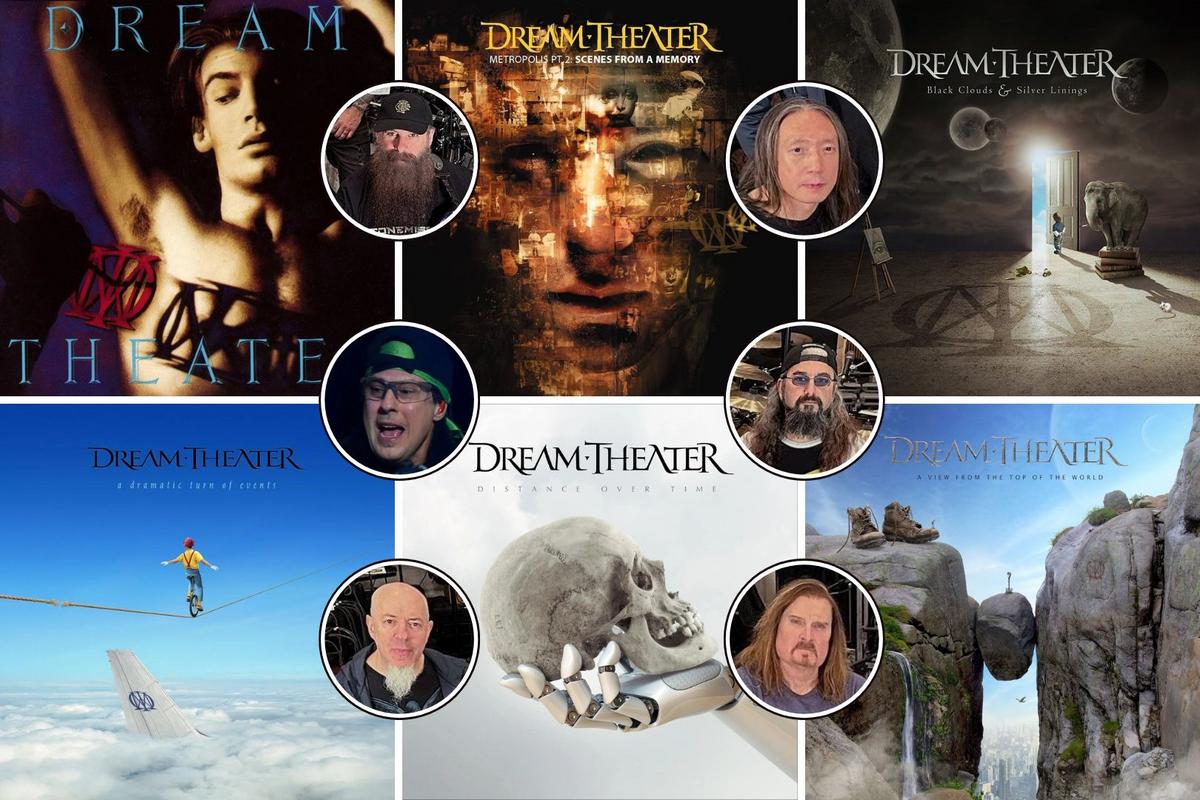Here’s the best song from every Dream Theater studio LP (except for 2025’s Parasomnia)!As someone who’s written a book on the band, I can confidently say that no other artist has had as much of an impact on the development of progressive metal as Dream Theater.Sure, Fates Warning, Queensrÿche, Iron Maiden, Voivod, Watchtower and Savatage brought trickier arrangements and/or deeper concepts/narratives to 1980s heavy metal. However, it was Dream Theater’s initial two LPs (1989’s When Dream and Day Unite and more importantly, 1992’s Images and Words) that truly fused the aggressiveness of Metallica, Led Zeppelin and Black Sabbath with the colorful complexities of Genesis, Rush and Yes.What’s more, 2025 marks several important milestones for the quintet, including their 40th anniversary; the release of their 16th album, Parasomnia; and in conjunction with their new record, the return of founding drummer Mike Portnoy (whose last record with the group was 2009’s Black Clouds & Silver Linings).READ MORE: The Best Slayer Song From Every AlbumClearly, it’s the perfect time to decide and discuss what the best song is from every LP that preceded Parasomnia!Unsurprisingly, this was harder to do for certain albums than for others, as the band have several records with multiple classics! Plus, we’re considering only proper songs (with lyrics/vocals), so instrumentals, preludes, segues and the like don’t count.Now that we’re all on the same page, let’s dive into our picks for the single best song from each LP (ranging from When Dream and Day Unite to 2021’s A View from the Top of the World)!The Best Dream Theater Song From Every AlbumWhen Dream and Day Unite: “The Ones Who Help to Set the Sun”If “The Ytse Jam” qualified, it’d definitely be here, and while opener “A Fortune in Lies” is a strong starter, it’s “The Ones Who Help to Set the Sun” that leaves the greatest impression.Beginning with the sounds of someone driving during a thunderstorm (alongside chimes, foreboding bass and surreal keyboard patterns), its moody “Death of Spock” opening establishes the song’s chaotic chronicle of dreaming about death and then awakening with newfound optimism.Hectic rhythms and guitarwork follow as late frontman Charlie Dominici sings with affectively high-pitched panic. He may not have been right for Dream Theater (given that he was replaced by James LaBrie for Images and Words), but his urgent verses and rising choruses are quite compelling. The rest of the band move around Dominici’s voice with emblematic sophistication and adventurousness, foreshadowing their trademark style with purposeful emotion.“The Ones Who Help to Set the Sun” is far from top-tier Dream Theater, but it’s easily the standout song of When Dream and Day Unite.Images and Words: “Metropolis—Part I: ‘The Miracle and the Sleeper'”True, “Pull Me Under” remains Dream Theater’s biggest song, and closer “Learning to Live” does an exceptional job of reprising “Wait for Sleep” while channeling the pastoral peak of Jethro Tull’s prog rock heyday. Even so, we must go with “Metropolis—Part I: ‘The Miracle and the Sleeper’” since it’s one of the group’s best compositions (and not just because it foreshadows its full-length sequel, which is arguably the greatest progressive metal album of all time).The blend of chilling sleighbells, tumultuous percussion, dreamy synths and threatening guitar playing at the start immediately makes it playfully epic, vibrant and ominous. Already, Dream Theater have demonstrated how much they’ve progressed – no pun intended – from their debut album, with this section (completed by LaBrie’s enticingly operatic singing and storytelling) rivaling much of what they’d do over the ensuing decades.The instrumental break during the second half is what seals the deal, though, since it delivers a perfect compromise between flashy showmanship and touching melodic shifts. In particular, guitarist John Petrucci and keyboardist Kevin Moore captivate as they unite and juxtapose each other with gripping riffs and quirky timbres. Along the way, bassist John Myung’s hypnotic solo is offset by Portnoy’s irregular counterpoints, and after a couple more minutes of flamboyant jamming, the fivesome ingeniously pivot toward the tender finale.Over 30 years later, “Metropolis—Part I” is still a mind-blowing game-changer.Awake: “Space-Dye Vest”This might be an unpopular opinion, but we have no reluctance in saying that Dream Theater’s third collection ends with its superlative (and most atypical) song: “Space-Dye Vest.” Penned by Moore (who announced his departure during the making of Awake), the piece was inspired by a model he saw in a magazine who was wearing – you guessed it – a space-dye vest. Moore had recently ended a relationship and he was projecting his need to give and receive affection onto her.Everything about the tune oozes romantic defeat and yearning, with its classical piano prelude evoking something Andrew Lloyd Webber might’ve written for The Phantom of the Opera. Once it kicks into gear, it’s a beautifully devastating experience, with Moore’s morose motif coating LaBrie’s bleak admittances (“Love is an act of blood and I’m bleeding / A pool in the shape of a heart / Beauty projection in the reflection / Always the worst way to start”).Industrial sound effects and passages from several media clips (namely, 1985’s A Room With a View) cleverly add intrigue, authenticity and nuance to Moore’s feelings of desire and longing. As it wraps up, distressed percussion and other elements enhance the sense of desperation, fading out as LaBrie’s final confession (“And I’ll smile and I’ll learnt o pretend / And I’ll never be open again”) captures what Moore – and virtually anyone else who’s been in his situation – felt about their recent heartbreak.Falling into Infinity: “Hollow Years”Dream Theater’s only studio LP with keyboardist Derek Sherinian (who briefly took over for Kevin Moore), 1997’s Falling into Infinity is often dismissed as underwhelmingly commercial. While it’s undoubtedly their worst ‘90s album, that’s due more to the excellence of its siblings than it is to the quality of Falling into Infinity. Honestly, it has some stellar compositions, with Petrucci’s lead single – “Hollow Years” – landing at the top of the list.A breezily lovelorn ballad, the track is instantly inviting thanks to its European-esque acoustic guitarwork; easygoing but dynamic drumming; and softly sung lamentations (most likely about the end of a romantic partnership). The backing harmonies are a lovely touch, as is Sherinian’s understated but impactful playing.In general, it’s one of Dream Theater’s most restrained pieces, but that’s a good thing since incorporating their characteristic theatricality would do a disservice to the heartfelt nature of “Hollow Years.”Metropolis Pt. 2: Scenes from a Memory: “Scene Eight: The Spirit Carries On”There are dozens of things that make 1999’s Metropolis Pt. 2: Scenes from a Memory (which marked the introduction of keyboardist Jordan Rudess) an almost perfect and highly profound journey. Clearly, its poignant storytelling and songwriting are as essential as anything else, and “The Spirit Carries On” is – by a large margin – the record’s shining example of that. In fact, it might be the best song Dream Theater have ever written, which – as you can already tell – is quite the accomplishment.It’s incredibly powerful both within and outside of the LP’s narrative, with LaBrie’s initial existential questions (“Where did we come from? Why are we here? Where do we go when we die? What lies beyond? And what lay before? Is anything certain in life?”) provoking listeners to reflect on their own mortality. Delivered with absolute genuineness over gentle piano chords and acoustic guitar strums, it’s a beautifully thought-provoking way to begin.From there, the arrangement becomes increasingly elaborate (including a gorgeous electric guitar solo from Petrucci alongside Floydian gospel chants) without stealing the spotlight; instead, it all punctuates the wide-ranging emotions and sentiments LaBrie expresses. Of course, his victorious callback to opener “Scene One: Regression” (“Safe in the light that surrounds me / Free of the fear and the pain / My questioning mind / Has helped me to find / The meaning in my life again”) is the tear-jerking icing on the cake.Beyond representing protagonists Nicholas and Victoria fully coming to terms with their tragic connections, “The Spirit Carries On” is a sublime philosophical gift to anyone who’s lost loved ones and/or doubted their purpose in life.Six Degrees of Inner Turbulence: “The Glass Prison”The first entry in Portnoy’s multi-album “Twelve-Step Suite” – which was inspired by his recovery from substance abuse – “The Glass Prison” includes three movements: “Reflection,” “Restoration” and “Revelation.” It’s dedicated to the co-founder of Alcoholics Anonymous (Bill Wilson), and as Portnoy famously explained, the first step “in the first section . . . is admitting [to] being powerless; the second step is needing the help of others, came to believe a power greater than ourselves to restore sanity; [and] the third section is being willing to turn your life over to a higher power and handing over your will.”The song emerges out of the leftover static from Metropolis Pt. 2 and evolves into one of Dream Theater’s most gripping and iconic introductions. Anxiety-inducing rhythms set the stage as Petrucci and Rudess sneakily establish and cathartically release their enthralling central theme (thereby exemplifying why they’re among progressive metal’s finest guitar and keyboard duos). It’s a delightfully colorful yet dramatic lead-in for the frenzied music, singing and sound effects that complete “Reflection.”Unconventionally, “Restoration” begins with sludgy guitar chords and record spinning before LaBrie and Portnoy dish out more combative call-and-response exchanges. LaBrie’s chorus (“Help me / I can’t break out this prison all alone”) is soothing, though, and the closing guitar and keyboard solos are wonderfully eccentric. Yet, overall, this middle section does a great job of signifying Portnoy’s inner chaos.In contrast, “Revelation” is all about purification, with LaBrie alluringly symbolizing Portnoy’s conquering of “the glass prison” that “once held” him. His final, well, revelations are heartwarming, and coupled with the sounds of glass shattered, “The Glass Prison” ends on an encouragingly triumphant note.Train of Thought: “This Dying Soul”The direct continuation of “The Glass Prison,” “This Dying Soul” incorporates the fourth and fifth steps of Portnoy’s suite: “Reflections of Reality (Revisited)” and “Release.” In keeping with the exceptional heaviness of the LP as a whole, “This Dying Soul” is probably the most aggressive section of the “Twelve-Step Suite.”Kicking off with downright belligerent riffs and rhythms, “Reflections of Reality (Revisited)” attractively foreshadows its key motifs during its preliminary (instrumental) minutes. After the quintet calm down a bit, LaBrie wistfully references “Mirror” from Awake and “Regression” from Metropolis Pt. 2 at least a couple of times each (such as with his starting line: “Hello, mirror / So glad to see you, my friend / It’s been a while”). Next, his chorus (“I want to heal your conscious making / A change to fix this dying soul”) is quite mesmerizing, as is Petrucci’s cyclical guitarwork afterward.Following more enticing hostility and distorted rapping (which connects to the hip-hop experimentation of “The Glass Prison”), the comforting bridge – “Now that you can see all you have done / It’s time to take that step into the kingdom” – gives way to “Release.” Cleverly, it commences with the same riffs as “Restoration” from “The Glass Prison” and it’s steered by more instrumental turmoil as LaBrie and Portnoy continue their previous call-and-response tactic. Finally, other connected themes are cunningly strewn throughout Dream Theater’s turbulent wind down.“This Dying Soul” isn’t as ambitious or fascinating as “The Glass Prison,” but it’s a superb successor and the multifaceted highlight of Train of Thought.Octavarium: “Octavarium”The closing blockbuster of its namesake LP, the 24-minute “Octavarium” saw Dream Theater incorporating an orchestra into their arrangements while paying overt homage to their prog and hard rock forefathers. At times, it’s a bit too dragged out musically (and bluntly referential lyrically), but there’s no denying that it’s one of the group’s most outstanding compositions and one of the greatest epic tracks in modern progressive music.It’s broken into five parts – “Someone Like Him,” “Medicate (Awakening),” “Full Circle,” “Intervals” and “Razor’s Edge” – and, like the tunes that precede it, ties into the album’s overarching gimmick of referencing the octave by starting in the key of F (just as opener “The Root of All Evil” does). For the sake of brevity, though, we won’t dissect each segment like we did for the prior two pieces.Its ongoing tribute to Dream Theater’s inspirations is apparent from the jump, with the atmospheric first few minutes (comprised of piecing guitar notes over serene keyboard tones) evoking Pink Floyd’s “Shine On You Crazy Diamond (Parts I – V).” It a while to get where it’s going, but it’s very enjoyable all the same, as is Petrucci’s classy acoustic guitarwork as LaBrie softly sings his opening confessions.The sing-along nature of the next passage (“Medicate me, infiltrate me/ Side effects appear as my conscience slips away”) is equally engaging and commendably vintage. Naturally, Dream Theater subsequently erupt into an instrumental break that’s especially playful (recalling the keyboard theatrics of vintage Yes and Genesis in the process). Then, it transforms into something sinister as LaBrie antagonistically alludes to numerous other people, artists and songs (including the Beatles, Queen and the Doors), only to then give way to a jaw-droppingly irregular rhythmic breakdown and more instrumental fury and flamboyance.The rest of “Octavarium” upholds that manic malevolence before returning to its starting point and, although it could be a tad more concise and focused, it’s a phenomenal way to honor Dream Theater’s forebearers amidst capturing the group during their most vibrantly adventurous phase.Systematic Chaos: “In the Presence of Enemies”Yes, “In the Presence of Enemies” is split into two bookended halves, but for all intents and purposes, it’s one song. Divided into six chapters (“Prelude,” “Resurrection,” “Heretic,” “The Slaughter of the Damned,” “The Reckoning” and “Salvation”), it’s inspired by a Korean manhwa (comic) called Priest and ties into the dark fantasy throughline of Systematic Chaos. Consequently – and in contrast to the vivid bounciness of “Octavarium” – “In the Presence of Enemies” is considerably coarse and shadowy.Unsurprisingly, it gets going with a hypnotically complex instrumental prelude where silky guitar notes and challenging start/stop percussion make it feel heroic yet menacing. It elegantly segues into “Resurrection” by building upon a central theme as LaBrie’s begins his fittingly mythical storytelling. It’s a satisfyingly wicked combination that surely pleases fans of Dream Theater’s bleaker and rougher side.After Petrucci’s lightning fast solo, ominous sounds of wind bridge the gap between the two halves and lead into the intriguingly brooding “Heretic.” Its intimidating sparseness is extremely effective, and LaBrie’s leisurely singing is just as seductively evil. The arrangement develops wisely, too, prior to transitioning into the heavy metal vehemence of “The Slaughter of the Damned.” The ensuing instrumental jam is compelling, despite being a bit too mechanical.Of course, it eventually ties back to the start of “In the Presence of Enemies” as it concludes. It’s another largely absorbing dive into Dream Theater’s penchant for extensive multi-part excursions.Black Clouds & Silver Linings: “A Nightmare to Remember”Although they didn’t know it at the time, 2009’s Black Clouds & Silver Linings would be Dream Theater’s final album with Portnoy until 2025’s Parasomnia. Regardless of it being uneven in quality, it contains at least three of the best tunes they recorded during the latter 2000s (“The Count of Tuscany,” “The Shattered Fortress” and “A Nightmare to Remember”).Ultimately, the top spot goes to opener “A Nightmare to Remember,” a thoroughly captivating retelling of a near-death car accident Petrucci was involved in during childhood.Explosions of thunder set the stage alongside Rudess’ subtly foreboding piano motif. Shortly thereafter, the music gets more intense and dynamic – with Portnoy and Myung’s resourceful interplay standing out – as LaBrie matter-of-factly paints a picture of what happened during the wreck. The arrangement, complemented by his gravely verses and operatic chorus, live up the title, and the sounds of cars crashing add to the anxiety.As appealing as the track already is, it’s the mellower middle section that elevates “A Nightmare to Remember” to the next level. Hospital sounds permeate LaBrie’s vulnerable recounting of events before soothing guitar strums and synths introduce what’s possibly the greatest melody Dream Theater ever wrote (“Hopelessly drifting / Bathing in beautiful agony”). It’s an absolutely magnificent passage in every way, with some of Petrucci’s most poetically resonant lyrics to date.Expectedly, some wild jamming follows, with Petrucci and Rudess trading off licks. Then, “A Nightmare to Remember” wraps up with Portnoy trying his hand at gruff singing, more instrumental histrionics and some pleasing callbacks during the outro. By the end, it’s damn a near flawless composition.A Dramatic Turn of Events: “Breaking All Illusions”As its name suggests, A Dramatic Turn of Events arrived shortly after the shocking departure of Portnoy. As such, it represented a fresh chapter for Dream Theater, with Mike Mangini taking over drum duties and the newly revised quintet having a lot to prove. Fortunately, they rebounded with their finest record since at least 2005’s Octavarium (and, in hindsight, the finest record of the Mangini era).Honestly, this was one of the most difficult entries to nail down because there are so many excellent choices. When push comes to shove, though, it’s the penultimate “Breaking All Illusions” that best captures everything great about the LP.It begins with one of the band’s most engrossing wordless preludes (steered by Petrucci and Rudess’ dizzyingly intricate and moving structures). It immediately seems epic and emotional, and with LaBrie’s light and encouraging declarations, it gratifyingly conjures the tranquil magic of “A Change of Seasons” and “Octavarium.” Naturally, the group alternates between this hectic nature and catharsis as they edge toward a wonderfully bonkers instrumental voyage (complete with some of Rudess’ most inventive textural changeups ever).The second half commences by placing Petrucci’s purifying solo over calming keyboard chords and gentle syncopation. It doesn’t take long, however, for Dream Theater to launch back into their trademark tumultuousness, with Rudess’ carnival-esque progressions coating Petrucci’s six-string puzzles and more enthrallingly off-kilter rhythms.LaBrie’s reprised chorus is a nice touch, too, cementing “Breaking All Illusions” as the apex of an all-around outstanding collection.Dream Theater: “Behind the Veil”Inspired by the 2002 kidnapping of 14-year-old Elizabeth Smart, “Behind the Veil” – like much of Dream Theater – purposely epitomizes Dream Theater’s ability to be “compact” and concise.Its initial synth collage conveys childlike wonder and the emptiness of inexplicable tragedy – making it quite powerful – and luckily, the run-of-the-mill verses and guitar riffs that follow are saved by gentle pianowork and the bittersweet pre-chorus (“I am finding courage in my darkest hour”). The chorus itself becomes significantly more meaningful in the context of what Smart endured and Rudess and Petrucci’s team-up during the climax is suitably expressive.The Astonishing: “A Better Life”Say what you will about the fivesome’s most underrated LP, but at least they tried something drastically different and ambitious. Although The Astonishing has its fair share of issues, it undeniably houses some standout material (“Moment of Betrayal,” “A Life Left Behind” and “A New Beginning,” for instance). Nevertheless, it’s “A Better Life” from Act I that rises to the top.Admittedly, it begins by highlighting The Astonishing’s penchant for soap opera schmaltziness, but it soon exudes relatively invigorating arrangements, lyrics and hooks as it touches upon an integral part of the plot. Arguably the most gripping portion of the entire 130-minute saga comes during the outro, when LaBrie sings, “Evangeline / You lived a life of misery and pain.”Sure, it borders on ‘80s power ballad cheesiness, but it’s subtly intoxicating in a way that’s difficult to describe and even harder to refute. While there are numerous reasons for why The Astonishing could’ve been better, “A Better Life” really isn’t one of them.Distance Over Time: “Pale Blue Dot”“Pale Blue Dot” takes its name and subject matter from the Voyager 1 space probe’s 1990 picture of Earth (as well as Carl Sagan’s 1994 book, Pale Blue Dot: A Vision of the Human Future in Space).This Distance Over Time song effectively uses spacey textures and voiceovers to set the scene and Rudess’ synths bring cosmic intrigue to the onslaught of irregular riffs and rhythms. What comes next is generally old hat, with a chorus – “God creators / Dream Destroyers” – that seems lifted straight out of the “Heretic” section of “In the Presence of Enemies.” However, the midway instrumental break is sufficiently engaging thanks to Mangini and Myung’s stampeding unpredictability alongside Petrucci and Rudess’ shifting timbres.“Pale Blue Dot” is rewardingly dynamic and contemplative enough to outdo the rest of Distance Over Time.A View From the Top of the World: “A View From the Top of the World”The Mangini era started with its best album, so it’s kind of poetic that it ends with its second-best album: 2021’s A View From the Top of the World. “The Alien,” “Sleeping Giant” and “Awaken the Master” were strong contenders for this entry due to them being surprisingly nuanced, diverse and nostalgic. As has often been the case with this list, though, we’re going with the record’s side-long suite and title track because it flows so well and offers a particularly absorbing passage.Expectedly, it’s separated into three movements (“The Crowning Glory,” “Rapture of the Deep” and “The Driving Force”), and although it kicks off with your standard Dream Theater aggressive theatricality, it eventually pulls you in with its upbeat chorus. The true peak of the journey comes immediately after, when the arrangement gets livelier as LaBrie belts out one of the most captivating melodies he’s sung since the aforementioned one from “A Nightmare to Remember” (“All my natural instincts / Are begging me to stop / But somehow I carry on / Heading for the top”).From there, “A View From the Top of the World” succeeds with intricately quirky instrumental breaks; pleasant harmonies during the atmospherically monumental “Rapture of the Deep” segment; and an impressively cinematic and grand finale.It’s a superb way to cap off Mangini’s time in the band.The Best Album by 10 Huge Prog Metal BandsKeep scrolling to see why these albums are the best of the bunch!Gallery Credit: Jordan Blum







